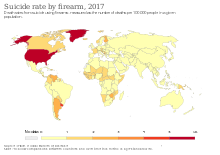Suicide Method
Worldwide, three suicide methods predominate, with the pattern varying in different countries; these are hanging, pesticides, and firearms. Some suicides may be preventable by removing the means. Making common suicide methods less accessible leads to an overall reduction in the number of suicides.
Some method-specific ways to do this include: restricting access to pesticides, firearms, and commonly used drugs. Other important measures are the introduction of policies that address the misuse of alcohol and the treatment of mental disorders. Gun-control measures in a number of countries have seen a reduction in suicides and other gun-related deaths. Other preventive measures are not method-specific; these include support, access to treatment, and calling a crisis hotline. There are multiple talk therapies that reduce suicidal thoughts and behaviors regardless of method, including dialectical behavior therapy (DBT).
Purpose of study
The study of suicide methods aims to identify those commonly used, and the groups at risk of suicide; making methods less accessible may be useful in suicide prevention. Limiting the availability of means such as pesticides and firearms is recommended by a World Health Report on suicide and its prevention. The early identification of mental disorders and substance abuse disorders, follow-up care for those who have attempted suicide, and responsible reporting by the media are all seen to be key in reducing the number of deaths by suicide. National suicide prevention strategies are also advocated using a comprehensive and coordinated response to suicide prevention. This needs to include the registration and monitoring of suicides and attempted suicide, breaking figures down by age, sex, and method.
Such information allows public health resources to focus on the problems that are relevant in a particular place, or for a given population or subpopulation. For instance, if firearms are used in a significant number of suicides in one place, then public health policies there could focus on gun safety, such as keeping guns locked away, and the key inaccessible to at-risk family members. If young people are found to be at increased risk of suicide by overdosing on particular medications, then an alternative class of medication may be prescribed instead, a safety plan and monitoring of medication can be put in place, and parents can be educated about how to prevent the hoarding of medication for a future suicide attempt.
Media reporting

Media reporting of the methods used in suicides is "strongly discouraged" by the World Health Organization, government health agencies, universities, and the Associated Press among others. Detailed descriptions of suicides or the personal characteristics of the person who died contribute to copycat suicides (suicide contagion). Dramatic or inappropriate descriptions of individual suicides by mass media has been linked specifically to copycat suicides among teenagers. Writing for the New Yorker about celebrity suicides, Andrew Solomon wrote that "You who are reading this are at statistically increased risk of suicide right now." In one study, changes in how news outlets reported suicide reduced suicides by a particular method.
Media reporting guidelines also apply to "online content including citizen-generated media coverage". The Recommendations for Reporting on Suicide, created by journalists, suicide prevention groups, and internet safety non-profit organizations, encourage linking to resources such as a list of suicide crisis lines and information about risk factors for suicide, and reporting on suicide as a multi-faceted, treatable health issue.
Method restriction
Method restriction, also called lethal means reduction, is an effective way to reduce the number of suicide deaths in the short and medium term. Method restriction is considered a best practice supported by "compelling" evidence. Some of these actions, such as installing barriers on bridges and reducing the toxicity in gas, require action by governments, industries, or public utilities. At the individual level, method restriction can be as simple as asking a trusted friend or family member to store firearms until the crisis has passed. According to Danuta Wasserman, professor in psychiatry and suicidology at Karolinska Institute, choosing not to restrict access to suicide methods is unethical.
Method restriction is effective and prevents suicides. It has the largest effect on overall suicide rates when the method being restricted is common and no direct substitution is available. If the method being restricted is uncommon, or if a substitute is readily available, then it may be effective in individual cases but not produce a large-scale reduction in the number of deaths in a country.
Method substitution is the process of choosing a different suicide method when the first-choice method is inaccessible. In many cases, when the first-choice method is restricted, the person does not attempt to find a substitute. Method substitution has been measured over the course of decades, so when a common method is restricted (for example, by making domestic gas less toxic), overall suicide rates may be suppressed for many years. If the first-choice suicide method is inaccessible, a method substitution may be made which may be less lethal, tending to result in fewer fatal suicide attempts.
In an example of the curb cut effect, changes unrelated to suicide have also functioned as suicide method restrictions. Examples of this include changes to align train doors with platforms, switching from coal gas to natural gas in homes, and gun control laws, all of which have reduced suicides despite being intended for a different purpose.
List
Suffocation
Suffocation, as a classification of suicide method, includes strangulation and hanging.
Suicide by suffocation involves restricting breathing or the amount of oxygen taken in, causing asphyxia and eventually hypoxia. It is not possible to die simply by holding the breath, since a reflex causes the respiratory muscles to contract, forcing an in-breath, and the re-establishment of a normal breathing rhythm. Therefore, inhaling an inert gas such as helium or nitrogen, or a toxic gas such as carbon monoxide, is used to bring about unconsciousness. Certain devices such as exit bags are designed to be used with this method, and provide a way for the carbon dioxide to passively escape, which prevents the panic, sense of suffocation and struggling before unconsciousness, known as the hypercapnic alarm response caused by the presence of high carbon dioxide concentrations in the blood. As of 2010, organizations supporting a right to die promoted death by helium inhalation, although most cases using this method in the US were people with psychiatric conditions.
Hanging

Hanging is a common method of suicide. Hanging involves the use of a ligature such as a rope or cord attached to an anchor point with the other end used to form a noose placed around the neck. The cause of death will either be due to strangulation or a broken neck. About half of attempted suicides by hanging result in death. People who favor this method are usually unaware that it is often a "slow, painful, and messy method that [needs] technical knowledge".
Hanging is the prevalent means of suicide in impoverished pre-industrial societies, and is more common in rural areas than in urban areas.
Hanging was the most common method in traditional Chinese culture, as it was believed that the rage involved in such a death permitted the person's spirit to haunt and torment survivors. In the Chinese culture, suicide by hanging was used as an act of revenge by women and of defiance by powerless officials, who used it as a "final, but unequivocal, way of standing still against and above oppressive authorities". Chinese people would often approach the act ceremonially, including the use of proper attire.
Drowning

Suicide by drowning is the act of deliberately submerging oneself in water or other liquid to prevent breathing. It accounts for less than 2% of all suicides in the United States. People with dementia and schizophrenia have a higher risk of dying by drowning. Of those who attempt suicide by drowning in the US, about half die.
About 2% to 3% of suicides by drowning involve driving a vehicle into a body of water.
Poisoning
Suicide by poisoning, also called self-poisoning, is usually classed as a drug overdose when drugs such as painkillers or recreational drugs are used. The use of pesticides to self-poison is the most common method used in some countries. Poisoning through the means of toxic plants is usually slow and painful.
Pesticide

As of 2006, worldwide, around 30% of suicides were from pesticide poisonings. It was the leading suicide method in developing countries, with about half of suicide deaths in India involving poisoning, and most of those involving pesticides. The use of this method varies markedly in different areas of the world, from 0.9% in Europe to about 50% in the Pacific region. In the US, pesticide poisoning is used in about 12 suicides per year. The overall case fatality rate for suicide attempts using pesticide is about 10–20%; the risk of death increases if the person is also drunk at the time.
Method restriction is an effective way to reduce suicide by pesticide poisoning. In Finland, limiting access to parathion in the 1960s resulted in a rapid decline in both poisoning-related suicides and total suicide deaths for several years, and a slower decline in subsequent years. In Sri Lanka, both suicide by pesticide and total suicides declined after first toxicity class I and later class II endosulfan were banned. Overall suicide deaths were cut by 70%, with 93,000 lives saved over 20 years as a result of banning these pesticides. In Korea, banning a single pesticide, paraquat, halved the number of suicides by pesticide poisoning and reduced the total number of suicides in that country.
Drug overdose
A drug overdose involves taking a dose of a drug that exceeds safe levels. In the UK (England and Wales) until 2013, a drug overdose was the most common suicide method in females. In 2019 in males the percentage is 16%. Self-poisoning accounts for the highest number of non-fatal suicide attempts. In the United States about 60% of suicide attempts and 14% of suicide deaths involve drug overdoses. The risk of death in suicide attempts involving overdose is about 2%.
Overdose attempts using painkillers are among the most common, due to their easy availability over-the-counter. Paracetamol (also called acetaminophen) is the most widely used analgesic worldwide and is commonly used in overdose attempts. Paracetamol poisoning is a common cause of acute liver failure. If not treated, the overdose produces a long and painful illness, with symptoms of nausea, vomiting, sweating, and abdominal pain appearing several hours after ingestion and continuing for several days. People who take overdoses of paracetamol do not fall asleep or lose consciousness, although most people who attempt suicide with paracetamol wrongly believe that they will be rendered unconscious by the drug. Method-specific restriction through reducing package size in the UK and Ireland has reduced suicide deaths by drug overdose.
Carbon monoxide
A particular type of poisoning involves the inhalation of high levels of carbon monoxide (CO). Death usually occurs through hypoxia. A nonfatal attempt can result in memory loss and other symptoms.
Carbon monoxide is a colorless and odorless gas, so its presence cannot be detected by sight or smell. It acts by binding preferentially to the hemoglobin in the bloodstream, displacing oxygen molecules and progressively deoxygenating the blood, eventually resulting in the failure of cellular respiration and death. Carbon monoxide is extremely dangerous to bystanders and people who may discover the body; right-to-die advocate Philip Nitschke has therefore recommended against this method.
Before air quality regulations and catalytic converters, suicide by carbon monoxide poisoning was often achieved by running a car's engine in an enclosed space such as a garage, or by redirecting a running car's exhaust back inside the cabin with a hose. Motor car exhaust may have contained up to 25% carbon monoxide. Catalytic converters found on all modern automobiles eliminate over 99% of carbon monoxide produced. As a further complication, the amount of unburned gasoline in emissions can make exhaust unbearable to breathe well before a person loses consciousness.
Charcoal-burning suicide induces death from carbon monoxide poisoning. Originally used in Hong Kong, it spread to Japan, where small charcoal-burning heaters (hibachi) or stoves (shichirin) have been used in a sealed room. By 2001, this method accounted for 25% of deaths from suicide in Japan. Nonfatal attempts can result in severe brain damage due to cerebral anoxia.
Other toxins
Gas-oven suicide was a common method of suicide in the early to mid-20th centuries in some North American and European countries. Household gas was originally coal gas, also called illuminating gas, or town gas, which was composed of methane, hydrogen and carbon monoxide. Stoves of this era required one to manually ignite a pilot light with a match; without the combustion the gas cloud would spread unimpeded. Carbon monoxide poisoning was the proximate cause of death. Natural gas, introduced in the 1960s, is composed of methane, ethane and an odorant added for safety. The suicide rates by domestic gas fell from 1960 to 1980, as changes were made to the formula to make it less lethal.




